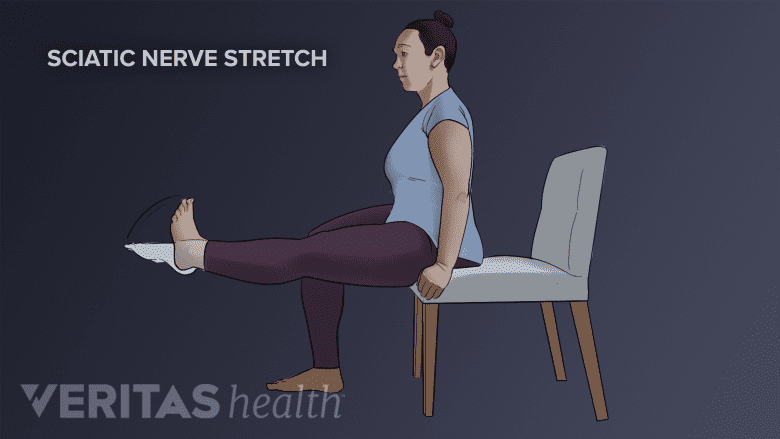Tightness in your lower back, abdominal, and/or hamstring muscles can worsen the pain along your sciatic nerve, which runs from your lower back to your feet. Loosen and strengthen those muscle groups by performing these 3 easy stretches:
1. Scissor hamstring stretch
Tight hamstring muscles can pull on your pelvis and increase stress on your lower back1Jandre Reis FJ, Macedo AR. Influence of Hamstring Tightness in Pelvic, Lumbar and Trunk Range of Motion in Low Back Pain and Asymptomatic Volunteers during Forward Bending. Asian Spine J. 2015;9(4):535–540. Available from: https://www.ncbi.nlm.nih.gov/pmc/articles/PMC4522442/, which can irritate your sciatic nerve.
Target your hamstrings with this standing stretch:
- Stand with your right foot in front of your left, about 3 feet apart.
- Face your hips and shoulders forward. If possible, check in a mirror to make sure your right hip isn’t more forward than your left hip.
- Place your hands on your hips. You can likewise put a hand on a chair on the side for balance.
- Bend forward at the waist, folding your torso forward over your front leg. Keep your back straight and most of your weight over the front leg.
- Hold for 5 to 10 seconds, then perform this stretch with the other leg.
Aim to complete 3 to 5 repetitions of this exercise on each leg.
Daily hamstring stretches can reduce sciatic nerve tension and relieve pain.
2. Back flexion stretch

Back flexion exercises gently stretch the mid and lower back tissues and reduce the mechanical compression on spinal nerve roots.
When you bend your spine forward, it is called flexion. Flexion exercises can help increase your spinal mobility, strengthen your abdominal musculature, and relieve tightness in your spinal and abdominal muscles.2Slater J, Kolber MJ, Schellhase KC, et al. The Influence of Exercise on Perceived Pain and Disability in Patients With Lumbar Spinal Stenosis: A Systematic Review of Randomized Controlled Trials. Am J Lifestyle Med. 2015;10(2):136–147. Published 2015 Feb 16. Available from: https://www.ncbi.nlm.nih.gov/pmc/articles/PMC6125093/
A simple back flexion while lying down involves the following steps:
- Lie on your back.
- Gently pull your knees to the chest with both hands until a comfortable stretch is felt in the mid and lower back.
- Slowly bring your head forward for a more advanced stretch.
- Hold for 5 to 10 seconds and return to the starting position.
Aim to complete 4 to 6 repetitions of this exercise.
Single knee-to-chest stretch This stretch is a variation of the above exercise and is also performed while lying down:

The knee-to-chest exercise stretches the muscles that originate from the hip, relieving tension and pressure across the lower back.
- While lying on your back, place your hand behind one knee and gently pull it towards your chest.
- A comfortable stretch should be felt in the lower back and buttock.
- Hold the stretch for 5 to 10 seconds and slowly return to the starting position.
Repeat with your other leg. Aim to complete 4 to 6 repetitions of this exercise on each leg.
Watch Video: Single Knee to Chest SI Joint Stretch for Sciatic Pain Relief
3. Sciatic nerve glide exercise

The sciatic nerve glide exercise helps relax and desensitize the sciatic nerve, improving the range of motion in the leg(s).
A seated exercise for sciatica relief is the sciatic nerve glide. This exercise helps relax and desensitize your sciatic nerve.
To perform this exercise:
- Sit upright on a chair and straighten one knee while keeping your other foot flat on the floor.
- Slowly bend your ankle so that your toes are pointing towards you.
- Continue to bend your ankle back and forth, pointing your toes away from you and then toward you.
- As tolerated, to put more tension on the sciatic nerve, try the same nerve glide with your head bent forward, bringing your chin toward your chest.
- Pump your ankle up and down 15 to 20 times and then repeat the exercise with your other leg.
Aim to complete 3 rounds for each leg, twice a day.
Stretches for conditions that mimic sciatica
Lower back and leg pain that mimics sciatica can also originate from other musculoskeletal sources, such as your sacroiliac joints (SI joint dysfunction) or your piriformis muscle (piriformis syndrome). In such cases, the lumbar rotation SI joint stretch and the supine piriformis stretch may help provide meaningful relief.
Gentle stretches that target the lower back and hips can help reduce sciatica pain, as well as improve range of motion. Try these stretches when your sciatica pain starts to flare up. In addition to decreasing the pain, the stretches can also help build strength and stability in your lower spine and legs and prevent future recurrences of sciatica.
Learn more:
- 1 Jandre Reis FJ, Macedo AR. Influence of Hamstring Tightness in Pelvic, Lumbar and Trunk Range of Motion in Low Back Pain and Asymptomatic Volunteers during Forward Bending. Asian Spine J. 2015;9(4):535–540. Available from: https://www.ncbi.nlm.nih.gov/pmc/articles/PMC4522442/
- 2 Slater J, Kolber MJ, Schellhase KC, et al. The Influence of Exercise on Perceived Pain and Disability in Patients With Lumbar Spinal Stenosis: A Systematic Review of Randomized Controlled Trials. Am J Lifestyle Med. 2015;10(2):136–147. Published 2015 Feb 16. Available from: https://www.ncbi.nlm.nih.gov/pmc/articles/PMC6125093/

